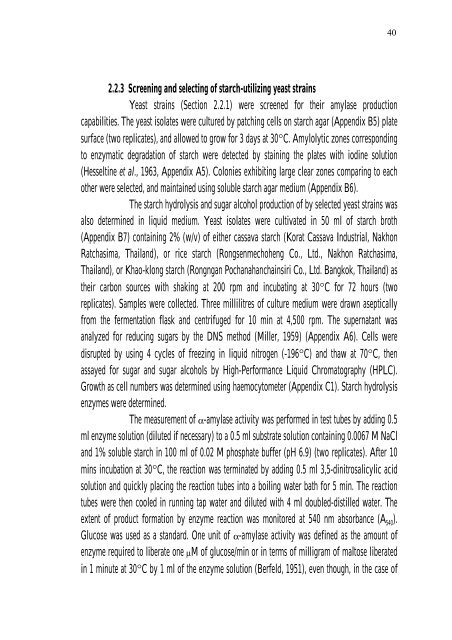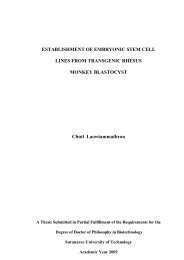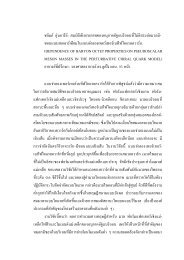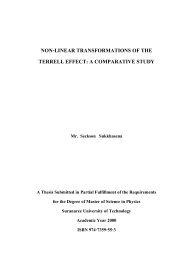PRODUCTION Of NUTRIENT SOURCES FOR RHIZOBIUM
PRODUCTION Of NUTRIENT SOURCES FOR RHIZOBIUM
PRODUCTION Of NUTRIENT SOURCES FOR RHIZOBIUM
Create successful ePaper yourself
Turn your PDF publications into a flip-book with our unique Google optimized e-Paper software.
2.2.3 Screening and selecting of starch-utilizing yeast strains<br />
Yeast strains (Section 2.2.1) were screened for their amylase production<br />
capabilities. The yeast isolates were cultured by patching cells on starch agar (Appendix B5) plate<br />
surface (two replicates), and allowed to grow for 3 days at 30°C. Amylolytic zones corresponding<br />
to enzymatic degradation of starch were detected by staining the plates with iodine solution<br />
(Hesseltine et al., 1963, Appendix A5). Colonies exhibiting large clear zones comparing to each<br />
other were selected, and maintained using soluble starch agar medium (Appendix B6).<br />
The starch hydrolysis and sugar alcohol production of by selected yeast strains was<br />
also determined in liquid medium. Yeast isolates were cultivated in 50 ml of starch broth<br />
(Appendix B7) containing 2% (w/v) of either cassava starch (Korat Cassava Industrial, Nakhon<br />
Ratchasima, Thailand), or rice starch (Rongsenmechoheng Co., Ltd., Nakhon Ratchasima,<br />
Thailand), or Khao-klong starch (Rongngan Pochanahanchainsiri Co., Ltd. Bangkok, Thailand) as<br />
their carbon sources with shaking at 200 rpm and incubating at 30°C for 72 hours (two<br />
replicates). Samples were collected. Three millilitres of culture medium were drawn aseptically<br />
from the fermentation flask and centrifuged for 10 min at 4,500 rpm. The supernatant was<br />
analyzed for reducing sugars by the DNS method (Miller, 1959) (Appendix A6). Cells were<br />
disrupted by using 4 cycles of freezing in liquid nitrogen (-196°C) and thaw at 70°C, then<br />
assayed for sugar and sugar alcohols by High-Performance Liquid Chromatography (HPLC).<br />
Growth as cell numbers was determined using haemocytometer (Appendix C1). Starch hydrolysis<br />
enzymes were determined.<br />
� The measurement of α-amylase activity was performed in test tubes by adding 0.5<br />
ml enzyme solution (diluted if necessary) to a 0.5 ml substrate solution containing 0.0067 M NaCl<br />
and 1% soluble starch in 100 ml of 0.02 M phosphate buffer (pH 6.9) (two replicates). After 10<br />
mins incubation at 30°C, the reaction was terminated by adding 0.5 ml 3,5-dinitrosalicylic acid<br />
solution and quickly placing the reaction tubes into a boiling water bath for 5 min. The reaction<br />
tubes were then cooled in running tap water and diluted with 4 ml doubled-distilled water. The<br />
extent of product formation by enzyme reaction was monitored at 540 nm absorbance (A 540).<br />
Glucose was used as a standard. One unit of α-amylase activity was defined as the amount of<br />
enzyme required to liberate one µM of glucose/min or in terms of milligram of maltose liberated<br />
in 1 minute at 30°C by 1 ml of the enzyme solution (Berfeld, 1951), even though, in the case of<br />
��






